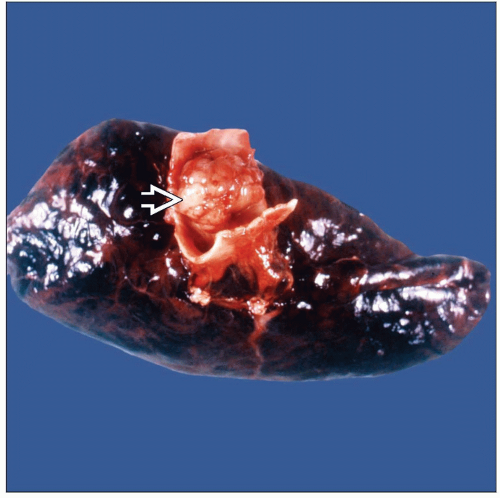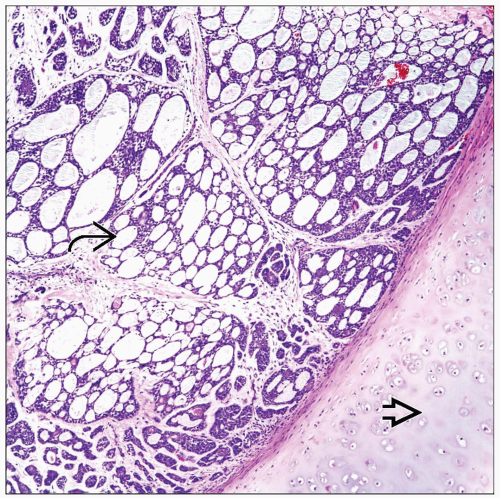Adenoid Cystic Carcinoma
Key Facts
Terminology
Epithelial neoplasm similar to that occurring in salivary glands
Clinical Issues
Presentation
Cough, hemoptysis, dyspnea, chest pain
Treatment
Lobectomy or pneumonectomy
Pathogenesis
May follow aggressive behavior with metastasis
Macroscopic Features
Endobronchial tumor
Submucosal mass, which may penetrate bronchial wall
Microscopic Pathology
Most common pattern cribriform with spaces within mass represent pseudocysts rather than glands
Perineural invasion is common as in salivary gland tumor of same type
Ancillary Tests
Immunohistochemical stains confirm immunophenotype of myoepithelial cells: Positive with CK-PAN, actin-sm, and vimentin
Top Differential Diagnoses
Adenocarcinoma
Diagnostic Checklist
Glands are composed of 2 rows of cells surrounding pseudocystic spaces
TERMINOLOGY
Synonyms
Cylindroma
Old term for this tumor related to the common cribriform growth pattern
Definitions
Epithelial neoplasm similar to that occurring in salivary glands
ETIOLOGY/PATHOGENESIS
Etiology
Tumor may originate from endobronchial glands
Rare in parenchymal location
CLINICAL ISSUES
Epidemiology
Incidence
2nd most common salivary gland type tumor of the lung after mucoepidermoid carcinoma
Age
Tumor appears to be more common in adults
Presentation
Cough
Hemoptysis
Shortness of breath
Chest pain
Treatment
Surgical approaches
Lobectomy or pneumonectomy
Prognosis
Slow-growth tumor
May follow aggressive behavior with metastasis
Recurrences are common
MACROSCOPIC FEATURES
General Features
Endobronchial tumor
Submucosal mass, which may penetrate bronchial wall
Size
1-3 cm in greatest dimension
MICROSCOPIC PATHOLOGY
Histologic Features
Cylindromatous or cribriform growth pattern
Spaces within mass represent pseudocysts rather than glands
Spaces result from compression of cords of cell coursing through myxoid stroma
Solid areas lack luminal structures and may show peripheral palisading
True mucin-producing glands may be seen but are extremely rare
Perineural invasion is common as in salivary gland tumor of same type
Predominant Pattern/Injury Type
Cylindromatous
Solid
Tubular
Predominant Cell/Compartment Type
Epithelial
ANCILLARY TESTS
DIFFERENTIAL DIAGNOSIS
Adenocarcinoma
Presence of cylindromatous pattern and myoepithelial immunophenotype is more in keeping with adenoid cystic carcinoma
Stay updated, free articles. Join our Telegram channel

Full access? Get Clinical Tree







